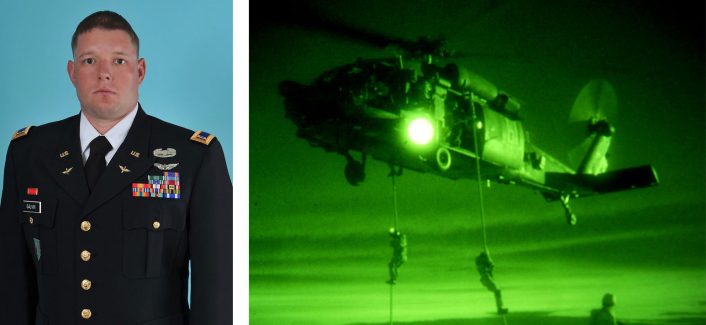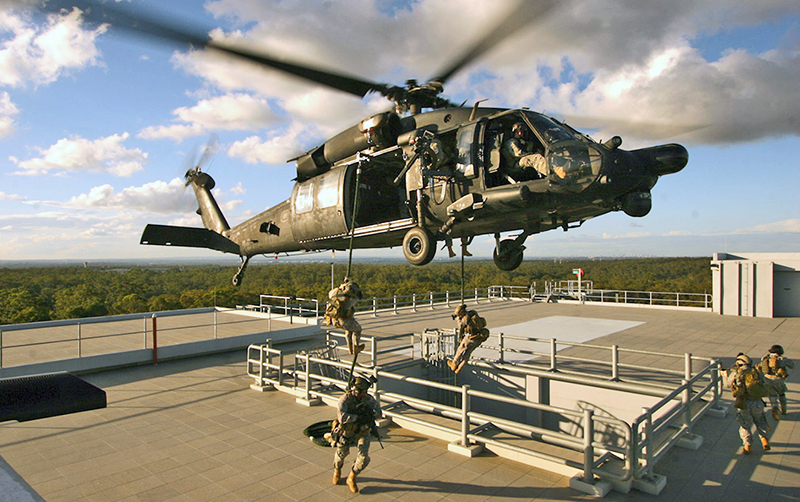Veteran Helicopter Pilot Killed in Crash Was in Ninth Combat Deployment.
Late Tuesday, August 21, 2018, U.S. military officials identified the Army helicopter pilot who died on Monday as a result of wounds received in a crash in Iraq on Sunday, August 19, 2018 during an undisclosed operation. Official news releases report three additional wounded U.S. personnel have been evacuated to treatment facilities.
Chief Warrant Officer 3 Taylor J. Galvin, 34, from Spokane, Washington, died Aug. 20, in Baghdad as a result of injuries sustained when his helicopter crashed in Sinjar, Ninevah Province, according to a Department of Defense news release.
CW3 Galvin was assigned to Delta Company, 1st Battalion, 160th SOAR (Special Operations Aviation Regiment) as an MH-60M Blackhawk helicopter pilot. He was flying in support of Operation Inherent Resolve. Galvin was originally from Phoenix, Arizona. He was 34 years old. Galvin was a combat veteran special operations pilot with nine deployments including two during Iraqi Freedom, three in Operation Enduring Freedom and four more during Operation Inherent Resolve. He was the recipient of the U.S. Army Air Medal (C device) and Air Medal (30LC) for heroism or meritorious achievement while flying in addition to numerous other awards.

In an August 20, 2018 article on Newsweek.com about the fatal crash, journalist James LaPorta reported that, “It is unclear why the MH-60 Blackhawk went down, but U.S. military sources with knowledge of the crash said the helicopter was returning to base after conducting a partnered small-scale raid on Islamic State militants in an undisclosed region as part of ongoing counterterrorism operations.” LaPorta went on to write, “Ten U.S. military personnel were onboard the aircraft being flown by U.S. Army pilots from the elite 160th Special Operations Aviation Regiment, known as the Night Stalkers.”
The region near Sinjar (Shingal), Iraq where the crash occurred had been active in supporting cross-border anti-ISIS operations into neighboring Syria for more than a month until U.S. troops were withdrawn from the area in the middle of July, 2018 according to a report by Wladimir van Wilgenburg published in the regional Kurdistan 24 online news source. This is also the region where Iraqi Air Force F-16s have conducted their first airstrikes against insurgents during cross-border strikes into Syria.
The crash was reported to have occurred at approximately 10:00 PM local time (2200 hrs, GMT+3). Sunset in the region on August 19, the date of the accident, occurred at 6:40 PM local time. Weather in the area was hot, 101 degrees Fahrenheit, with light winds and clear skies. Pentagon spokesman Colonel Robert Manning told reporters Monday that the crash was not caused by enemy fire.
Reports about the aircraft and the personnel on board may contradict official assertions that the U.S. role in the region is predominantly in an advisory capacity. The 160th Special Operations Aviation Regiment, the “Night Stalkers”, is a highly-specialized combat aviation unit headquartered at Ft. Campbell, Kentucky that supports elite U.S. and coalition combat units like Army Special Forces, Naval Special Warfare (SEALs) and other special operations units.
This latest crash brings the total of serious U.S. military aircraft accidents this year to at least 14.
The 160th SOAR, the “Night Stalkers”, are most famous for the raid to capture Osama bin Laden, Operation Neptune’s Spear, on May 1, 2011. During that raid, the unit flew a classified, low-observable variant of the Blackhawk helicopter that has since been popularly referred to in speculation as the “MH-X Stealth Black Hawk” or “Silent Hawk”. Images of part of the secret helicopter were seen around the world when one of them crashed inside Bin Laden’s compound during the raid, leaving the tail section visible. Books and media accounts suggest only two of the aircraft were ever produced.
In 2015, a MH-60M Black Hawk crashed on the deck of a U.S. Navy ship near Okinawa, Japan, injuring seven; more recently, in August 2017, a 160th SOAR’s MH-60 crashed off Yemen killing one soldier.
Top image credit: U.S. Army









